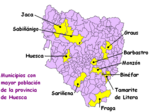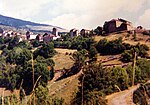The Diocese of Jaca is a Latin Church ecclesiastical territory or diocese of the Catholic Church in the northeastern Spanish province of Huesca, part of the autonomous community of Aragón. The diocese is a suffragan in the ecclesiastical province of the metropolitan Archdiocese of Pamplona y Tudela.The territory of the Diocese of Jaca was originally administered by the Diocese of Huesca, but after the Moorish conquest of Huesca in 713 its bishops, (known as the itinerant "Bishops of Aragon"), moved to Aragon. The episcopal see was established in Jaca during 1063–96, then moved back to Huesca after king Pedro I of Aragon retook the city from the Moors in November 1096. The Diocese of Jaca was created in 1572, carved out of the diocese of Huesca.
Jaca cathedral is dedicated to [Saint Peter]. Consecrated in the late 11th century and altered in the 15th–18th centuries, it is Romanesque in its architectural style. The church of San Adrián de Sasabe, in Sasabe (also in Huesca province) was an earlier diocesan cathedral.
A religious and civil festival is held on the first Friday of May, locally referred to as "Primer Viernes de Mayo", in memory of a victory said to have been won over the Moors in the 8th century by Count Aznar aided by the women of Jaca. It is celebrated with a solemn procession in which the entire cathedral chapter takes part.
There are many hermitages around Jaca, but none more interesting than that of San Juan de la Peña, ensconced within a cave in the Pyrenees. This shrine was also a monastery, royal mausoleum and -allegedly- one of the many hiding places of the Holy Grail in the middle ages. It continues to be a stop along the Camino de Santiago for many pilgrims and tourists. In another cave, dedicated to La Virgen de la Cueva, locals gather annually to pay homage to "Our Lade of the Cave", a venerated shrine where Garcí Ximénez was proclaimed first King of Sobrarbe in the 8th century.











